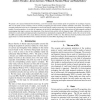640 search results - page 75 / 128 » Recognition Model with Extension Fields |
106
click to vote
CVPR
2003
IEEE
16 years 1 months ago
2003
IEEE
The recognition of activities from sensory data is important in advanced surveillance systems to enable prediction of high-level goals and intentions of the target under surveilla...
MICCAI
2005
Springer
16 years 23 hour ago
2005
Springer
Better physiological understanding of principles regulating vascular formation and growth is mandatory to their efficient modeling for the purpose of physiologically oriented medi...
HT
1997
ACM
15 years 3 months ago
1997
ACM
The hypermedia field has long realized the need for firstructural abstractions. However, we have failed to generalize the concept of ubiquitous structure management to problem dom...
124
click to vote
CIVR
2008
Springer
15 years 29 days ago
2008
Springer
This paper presents a semi-supervised learning (SSL) approach to find similarities of images using statistics of local matches. SSL algorithms are well known for leveraging a larg...
LREC
2010
15 years 18 days ago
2010
We present LIPS (Lexical Isolation Point Software), a tool for accurate lexical isolation point (IP) prediction in recordings of speech. The IP is the point in time in which a wor...


